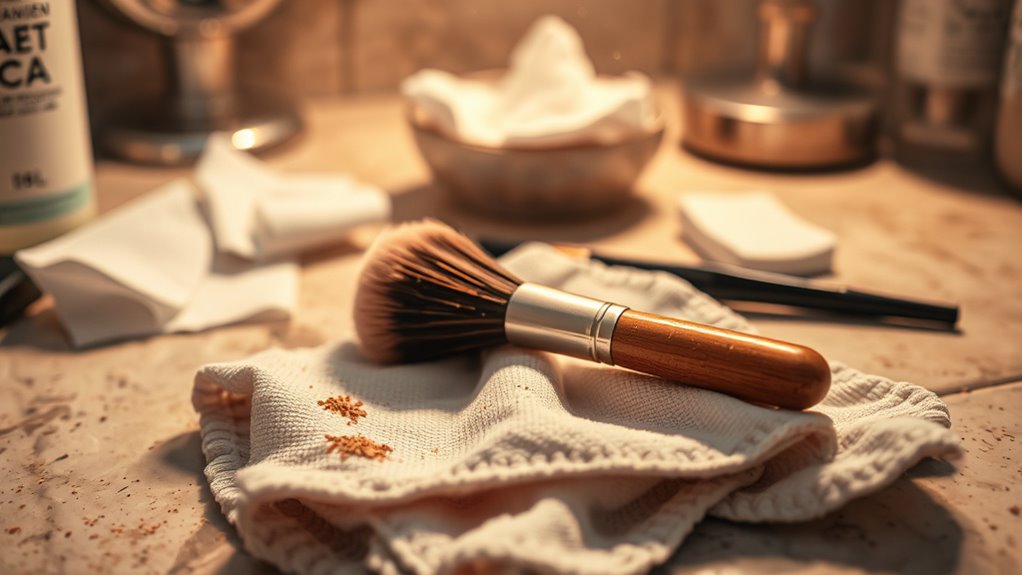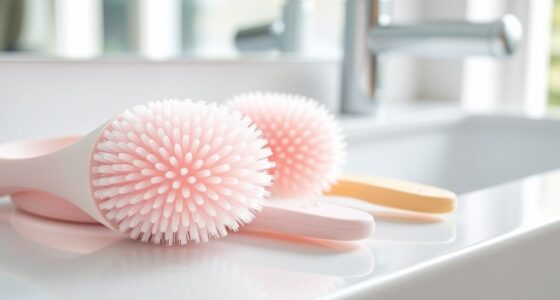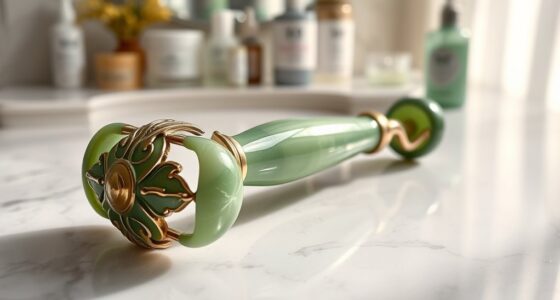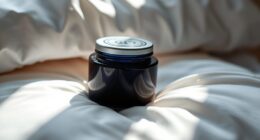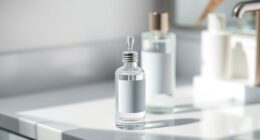Cleaning your beauty tools improperly can sabotage your skin by leaving bacteria, fungi, and residues that cause breakouts, irritation, and infections. Using harsh cleaners or not cleaning often enough damages your tools and weakens your skin’s natural barrier. Failing to dry tools completely allows bacteria and mold to grow, while sharing tools spreads germs. Skipping deep cleaning and disinfection risks more contamination. Keep going to discover how to maintain a healthier, clearer complexion through proper hygiene.
Key Takeaways
- Using harsh chemicals can weaken tools and leave residue that irritates your skin or triggers allergies.
- Infrequent or improper cleaning allows bacteria, fungi, and dirt to build up, causing breakouts and infections.
- Not drying tools completely creates a moist environment that promotes bacterial and mold growth, harming skin health.
- Sharing un sanitized tools spreads pathogens, increasing the risk of skin irritation, inflammation, and infections.
- Neglecting deep cleaning and proper storage can lead to contaminated tools that compromise your skin’s safety.
Using Harsh Cleaners That Damage Your Tools and Skin
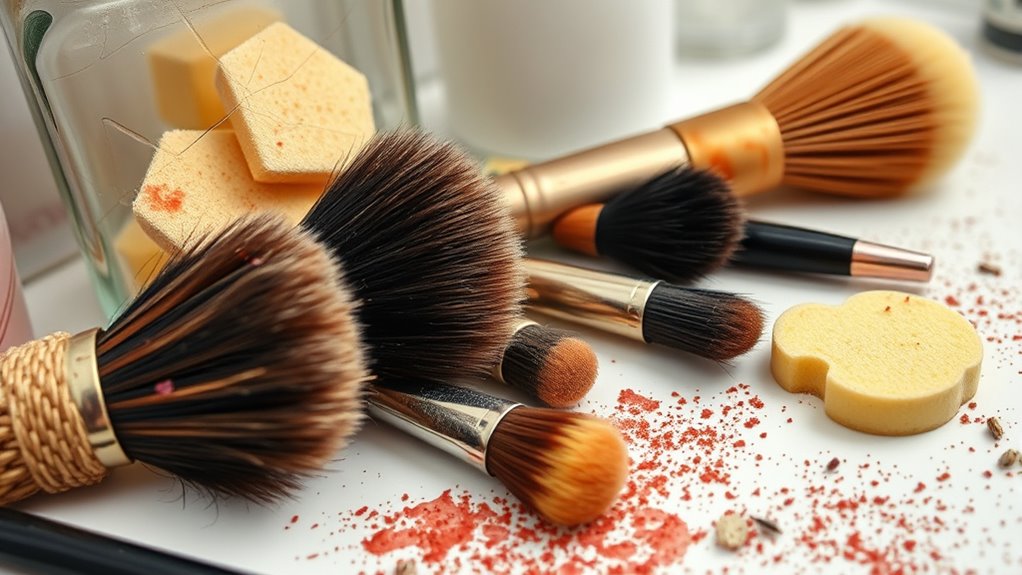
Many people assume that harsh cleaners are the best way to disinfect beauty tools, but in reality, these strong chemicals can do more harm than good. Using abrasive disinfectants can weaken or damage your tools, making them less effective and more prone to breakage. Plus, harsh chemicals can irritate your skin or cause allergic reactions when residue remains. Instead, opt for gentler solutions like isopropyl alcohol or mild soap and water. These methods effectively clean without compromising your tools’ integrity or risking skin irritation. Remember, overusing or misusing strong chemicals doesn’t speed up cleaning; it often leads to damage that can worsen your skin issues. Understanding the differences in cleaning methods can help you choose the safest option for your skin and tools. Additionally, selecting appropriate cleaning agents that are compatible with your tools ensures longevity and safety. Be aware that gentle cleaning techniques are recommended by skincare professionals to prevent damage to both your tools and your skin. Using proper cleaning methods can also prevent the buildup of bacteria and other harmful pathogens that may compromise your skin’s health. Incorporating proper storage practices can further maintain the cleanliness and longevity of your beauty tools. Protect your tools and your skin by choosing safe, effective cleaning methods rather than relying on aggressive cleaners.
Not Cleaning Frequently Enough or Properly
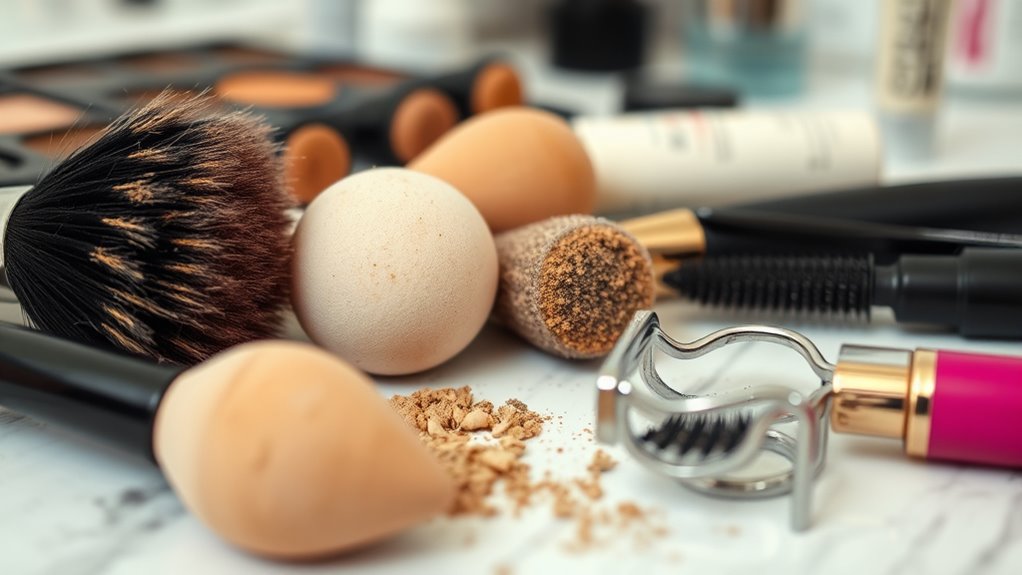
If you don’t clean your beauty tools regularly or thoroughly, bacteria and dirt can accumulate, increasing the risk of skin irritation, breakouts, and infections. When tools are neglected, germs thrive on their surfaces, transferring back onto your skin with each use. Proper hygiene practices involve more than just rinsing; it requires thorough scrubbing with suitable cleansers and drying. Skipping routine cleanings allows buildup of oils, dead skin cells, and bacteria that clog pores and cause acne. Many people underestimate how often tools need cleaning, thinking weekly is enough, but for daily use, cleaning after each session is ideal. Neglecting proper cleaning frequency and technique sabotages your skincare efforts, making your skin more prone to issues instead of helping it heal and stay clear. Additionally, implementing AI-powered automation in skincare routines can help monitor and remind you to clean your tools regularly, ensuring better skin health. Proper sanitation also involves understanding the different materials used in unique and wicked planters, which can affect how easily tools can be cleaned and sanitized effectively. Recognizing the importance of advanced data processing speeds can assist in developing smarter cleaning schedules and routines tailored to your specific skincare needs.
Failing to Dry Tools Completely Before Use
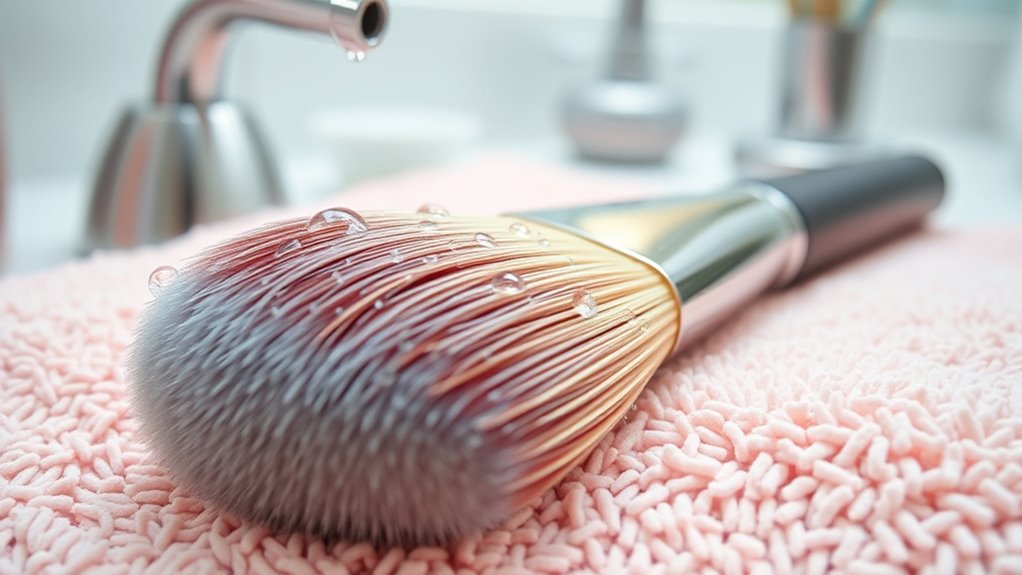
Failing to dry beauty tools completely before use can introduce bacteria and moisture onto your skin, increasing the risk of irritation and breakouts. Damp tools create an ideal environment for bacteria to thrive, which can transfer onto your skin during application. If you use a wet brush or sponge, you’re also risking product buildup and mold growth inside the tool. This can lead to clogged pores and infections. Always make certain your tools are thoroughly dried before use to prevent these issues. Use a clean towel or air-dry them in a well-ventilated area. Incorporating proper cleaning practices can further reduce bacteria build-up and promote healthier skin. Proper tool maintenance is essential for preventing the spread of bacteria and ensuring your skin remains clear. Ensuring your tools are stored in a clean environment helps prevent the accumulation of dust and other contaminants. Taking this extra step helps keep your skin clear and healthy, reducing the chance of irritation caused by residual moisture or bacteria. Additionally, using appropriate storage for your tools can help prevent dust and contaminants from settling on them when not in use. Recognizing the importance of angel number symbolism can also encourage mindful care of your beauty tools, as energetic cleanliness contributes to overall well-being. Don’t rush the drying process—your skin will thank you.
Sharing Beauty Tools Without Proper Sanitization
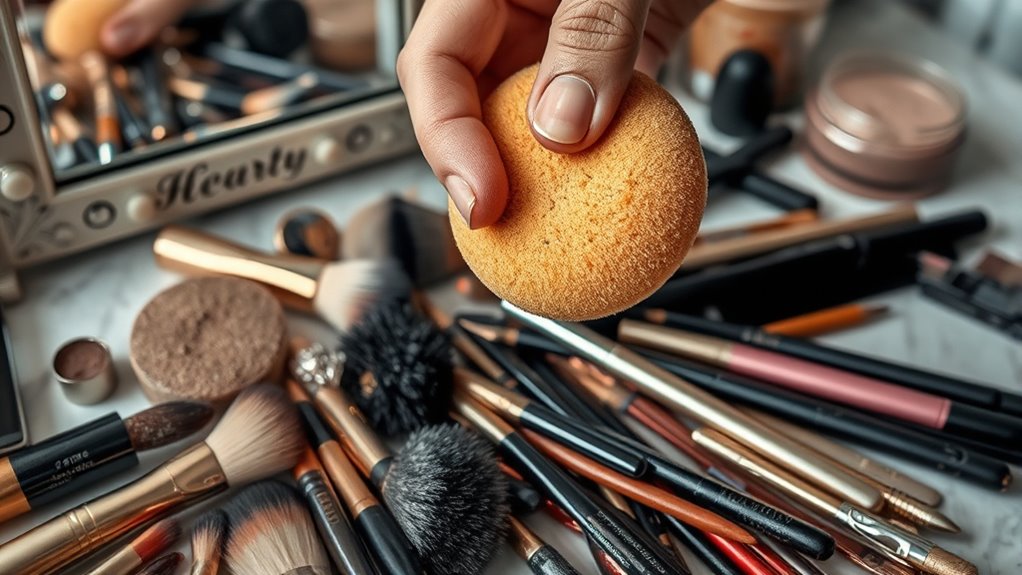
Sharing beauty tools without proper sanitization can quickly spread bacteria, fungi, and viruses from one person to another. When you use tools like brushes, sponges, or tweezers on someone else—or vice versa—you risk transferring germs that can cause breakouts, infections, and irritation. Even if tools look clean, they may harbor unseen microorganisms. If you don’t sanitize them thoroughly between uses, you’re contaminating your skin and theirs. This habit can lead to clogged pores, cysts, or contagious skin conditions. Always clean and disinfect your tools before sharing, and avoid sharing at all if possible. Proper sanitization isn’t just about cleanliness; it’s an essential step in protecting your skin’s health and preventing the spread of skin issues caused by contaminated tools. Regular cleaning and effective disinfecting techniques are crucial to ensure tools are truly safe for use. Incorporating proper cleaning techniques can further reduce the risk of cross-contamination and promote healthier skin. Additionally, understanding the benefits of using clean tools can motivate consistent sanitization practices to maintain skin integrity. Staying informed about technological advancements in sanitation can also help you choose the most effective disinfecting products and methods.
Overlooking the Importance of Deep Cleaning and Disinfection

Many people overlook the critical role of deep cleaning and disinfection in maintaining safe beauty routines. Regularly wiping your tools isn’t enough to eliminate bacteria, oils, and residue that build up over time. Without deep cleaning, these germs can cause breakouts, infections, and skin irritation. Disinfection kills harmful microbes that surface cleaning misses, reducing the risk of skin issues. Skipping this step can make your beauty routine counterproductive, even damaging your skin’s health. Make it a habit to thoroughly disinfect tools after each use, especially if you share them or use them on multiple areas. Proper deep cleaning and disinfection ensure your tools are truly clean and safe, helping you achieve better skin and prevent avoidable problems. Incorporating AI-powered sanitation devices can further enhance the effectiveness of your cleaning routine by utilizing advanced technology. Additionally, understanding industry trends can help you stay updated on the latest innovations in sanitation and skincare practices, including how Self Watering Plant Pots influence the development of new cleaning technologies and standards. Regularly updating your knowledge about hygiene practices is essential for maintaining optimal skin health and safety.
Frequently Asked Questions
Can the Wrong Cleaning Products Cause Skin Allergies?
Yes, using the wrong cleaning products can cause skin allergies. When you choose harsh chemicals or products not suited for your tools, you risk leaving residues that irritate your skin or trigger allergic reactions. Always opt for gentle, dermatologist-recommended cleaners, and guarantee your tools are thoroughly rinsed. Proper cleaning minimizes bacteria buildup and reduces allergy risks, helping you maintain healthier skin and avoid unnecessary discomfort.
How Often Should I Replace My Makeup Brushes?
You might find it surprising, but replacing your makeup brushes every few months is key to healthy skin. If you notice bristles fraying or shedding, it’s time for new ones. Regularly swapping them out prevents bacteria buildup and guarantees makeup applies smoothly. Even if they look clean, old brushes can harbor dirt. So, mark your calendar or set reminders—your skin will thank you for the fresh tools.
Are There Specific Tools That Require Special Cleaning Methods?
Some tools need special cleaning methods to stay effective and safe. For example, sponge applicators trap bacteria and should be washed weekly with gentle soap and water, then air-dried. Brushes with natural bristles require thorough cleaning to remove product buildup, while electronic devices like facial cleansing brushes need specific disinfectants. Always follow manufacturer instructions to avoid damaging your tools and guarantee they remain hygienic for your skin.
What Signs Indicate My Tools Need Deep Cleaning?
They say “a picture is worth a thousand words,” and the same applies to your tools. If you notice breakouts, skin irritation, or dullness, it’s time for a deep clean. Also, if brushes or sponges smell off or look visibly dirty, don’t ignore it. These signs show bacteria and buildup, which can sabotage your skin’s health. Regular deep cleaning keeps your tools—and your skin—fresh and clear.
Is It Safe to Use Household Items for Cleaning Beauty Tools?
Using household items to clean your beauty tools isn’t always safe. Some cleaners contain harsh chemicals that can damage your tools or leave residues on your skin, leading to irritation or breakouts. Instead, opt for gentle soap, brush cleaner, or alcohol-based solutions specifically designed for beauty tools. These guarantee thorough cleaning without risking your skin’s health. Always follow the manufacturer’s instructions for the safest, most effective results.
Conclusion
If you neglect proper cleaning, your beauty tools become a battleground for bacteria and residue, sabotaging your skin’s health. Think of your tools as tiny gateways; if left dirty or damaged, they invite trouble instead of beauty. By cleaning regularly, avoiding harsh cleaners, and ensuring they’re dry and sanitized, you’re fundamentally fencing off the chaos. Take control now—proper care turns your tools from potential villains into your skin’s best allies.
